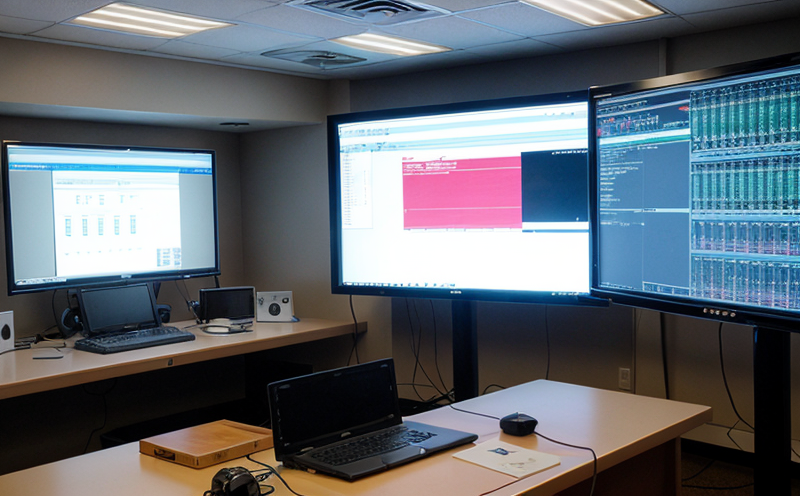ITU-T G.703 Digital Signaling Transmission Testing
The International Telecommunication Union (ITU) has established a series of recommendations to ensure global interoperability in telecommunications networks, and one of these is the ITU-T G.703 recommendation for digital signaling transmission testing. This standard provides guidelines for testing digital interfaces used in telecommunication networks, particularly focusing on the quality and reliability of digital signals.
The ITU-T G.703 digital signaling transmission test ensures that digital signals are transmitted accurately without distortion or loss over various types of communication channels such as copper wires, optical fibers, and wireless links. This is crucial in railway and transportation testing because it helps ensure the integrity of control systems which rely heavily on reliable data transmission.
The G.703 standard defines different levels of signaling (e.g., E1, T1) that are used for transmitting digital information between network devices. Testing these signals ensures they meet the specified performance criteria laid out by the ITU-T. For railway and transportation applications, this is particularly important for critical control systems like train communication networks, traffic management systems, and signaling infrastructure.
One key aspect of G.703 testing involves checking the integrity of digital signals during transmission, including bit error rate (BER) measurement, timing jitter analysis, and signal level verification. These tests are conducted using specialized equipment designed to simulate real-world conditions that the communication channels may encounter.
Another important feature of G.703 testing is its focus on synchronization between different network elements. Proper synchronization ensures that data packets arrive at their destination in a timely manner, which is essential for maintaining operational efficiency and safety in railway systems. The test also checks for the presence of noise and interference that could degrade signal quality.
For R&D engineers working on new signaling and control systems for railways or transportation networks, G.703 testing can provide valuable insights into potential issues with current designs before they are deployed. By identifying weaknesses early in the development process, it helps reduce costs associated with field failures while enhancing overall system reliability.
| Signal Type | Description | ITU-T Recommendation |
|---|---|---|
| E1 | European digital signaling standard with a rate of 2.048 Mbps. | ITU-T G.703 B.642 |
| T1 | North American digital signaling standard with a rate of 1.544 Mbps. | ITU-T G.703 B.802 |
Industry Applications
- Railway Communication Networks
- Transportation Management Systems
- Signaling Infrastructure for Trains
The ITU-T G.703 digital signaling transmission test is widely used in various sectors, but its primary application lies within railway and transportation systems where reliable communication between different components of the system is paramount.
In railway communication networks, ensuring that digital signals are transmitted accurately without any loss or distortion can prevent delays caused by signal degradation. This is especially important for real-time data transmission required for train control applications such as speed regulation, braking, and automatic train operation (ATO).
Transportation management systems benefit greatly from reliable signaling infrastructure provided by G.703 testing. These systems include traffic light coordination, tollbooth operations, and other forms of intelligent transportation solutions that depend on precise timing and synchronization across multiple nodes in the network.
Why Choose This Test
Selecting ITU-T G.703 digital signaling transmission testing is crucial for maintaining high standards of performance in railway and transportation systems. By adhering to this international standard, organizations can ensure their communication infrastructure meets the required quality levels set forth by leading telecommunications bodies.
The test offers several advantages over other methods available today:
- Comprehensive evaluation covering multiple aspects including bit error rate, timing jitter, and signal integrity.
- Use of advanced equipment capable of simulating diverse environmental conditions that the communication channels might encounter during operation.
- Precise identification of potential issues early in the development cycle, thereby reducing costs associated with field failures.
International Acceptance and Recognition
The ITU-T G.703 digital signaling transmission test is internationally recognized as a benchmark for ensuring the reliability of digital signals used in telecommunication networks, including those critical to railway and transportation systems.
This standard has been adopted by numerous countries around the world due to its stringent requirements and thorough approach towards testing. Organizations that comply with this standard gain credibility among clients and partners who value consistent quality in their services or products related to digital communication.
Compliance with ITU-T G.703 not only helps businesses meet regulatory requirements but also enhances customer confidence by demonstrating a commitment to excellence. This is particularly beneficial for companies operating within competitive markets where reputation plays a significant role in maintaining long-term relationships.
- Recognized globally by major telecom operators.
- Adopted by many national standards bodies worldwide.
- Affirmed by numerous international organizations involved in telecommunications and information technology development.





